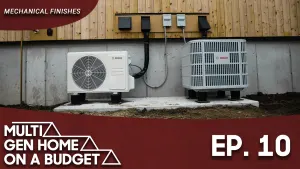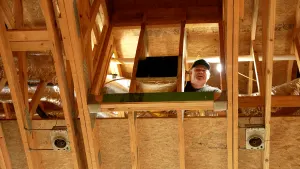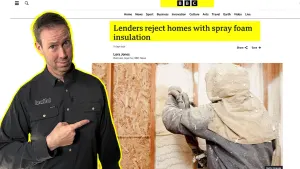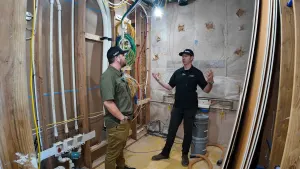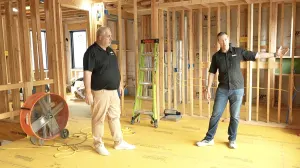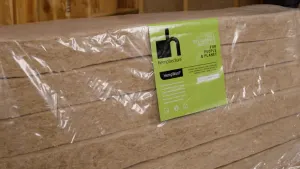Your home's lowest level could become your favorite spot by adding high style, functionality, and more space for living. Finishing a basement could provide amenities that you might otherwise feel you need a new home for: more bedrooms, more storage, or more space to entertain.
Yes, it's a basement, and some people have concerns about replacing sweaty concrete with drywall or damp flooring with carpet. For many people with dank basements, those concerns are valid, and you wouldn't add drywall or carpeting over a moisture problem, unless you wanted disastrous results, but by starting from the ground up, literally, and addressing any structural problems or moisture problems, and allowing for good indoor air quality by controlling moisture and humidity, your finished basement could be a beautiful addition to your home's square footage.
Water Issues
One key to drying out a wet basement is determining the source of the dampness. Is it coming from condensation, groundwater seeping through your foundation, or from water that isn't being diverted away from your home? Believe it or not, many water problems start far above the basement level with poor gutter installation. Work with a professional who can diagnose and fix any moisture problems before you do anything else with your basement. Seek out a company with experience in basement waterproofing and structural repair, as the problems often go hand in hand. If it’s just damp with no liquid water present consider adding a dehumidifier to the space. Even a plug-in 70 pint dehumidifier can make a big difference. Let it run a few weeks and if that dampness dissipates you’ll know that the dehum is doing its job and you can proceed. A plug-in would work well, but a more permanent install of a dehumidifier would be best.
Air Quality
Improving the air quality in your basement can reduce your household's exposure to mold, mildew, and even some pests, which thrive in damp, humid environments. When a basement is too damp, that moisture circulates throughout the rest of the house, and can lead to allergies, stuffy noses, headaches, sinus issues, or coughs. Finishing your basement and sealing off that moisture intrusion once and for all can create healthier, drier air throughout your entire home. Shoot for humidity that’s kept below 60%RH year round.
Building Codes
Building codes require egress windows in basements, especially if the room is to be considered a bedroom. Egress, as defined by local building codes, must be large enough for a firefighter in full gear to enter the home in case of fire, and for occupants to safely escape if necessary. Many older basements have very small or no windows, and this can be a point at which to start designing your basement.
Check the codes in your area, but generally the window must be positioned so that someone can climb in or out. If the window is too high to be accessible, consider placing built-in furniture such as a bench seat (with storage underneath!) to allow step-in step-out access. Plan first for your windows and doors, because cutting them in will introduce masonry dust. This is another task to outsource—have a building professional ensure the surrounding walls can take on the increased structural load.
Once You’ve Decided
Once your basement is structurally sound and watertight, you can begin to fill it with the furniture or toys you've dreamed about. Maybe it's that extra bedroom for the in-laws, or a pool table and bar, or a home entertainment center to keep your teenagers happy. Once moisture is controlled, you can finish the space with the same high-quality materials and decor you would put into the rest of your home.
The finished basement will increase the square footage of your home and will be attractive to prospective buyers should you decide to sell in the future. If you feel like you need a larger home but you really like the neighborhood you're in, finishing your basement provides the perfect solution to expanding your home’s square footage so you can stay where you are and enjoy the home you have.

 Share on facebook
Share on facebook Tweet
Tweet Email
Email Share on Linkedin
Share on Linkedin




